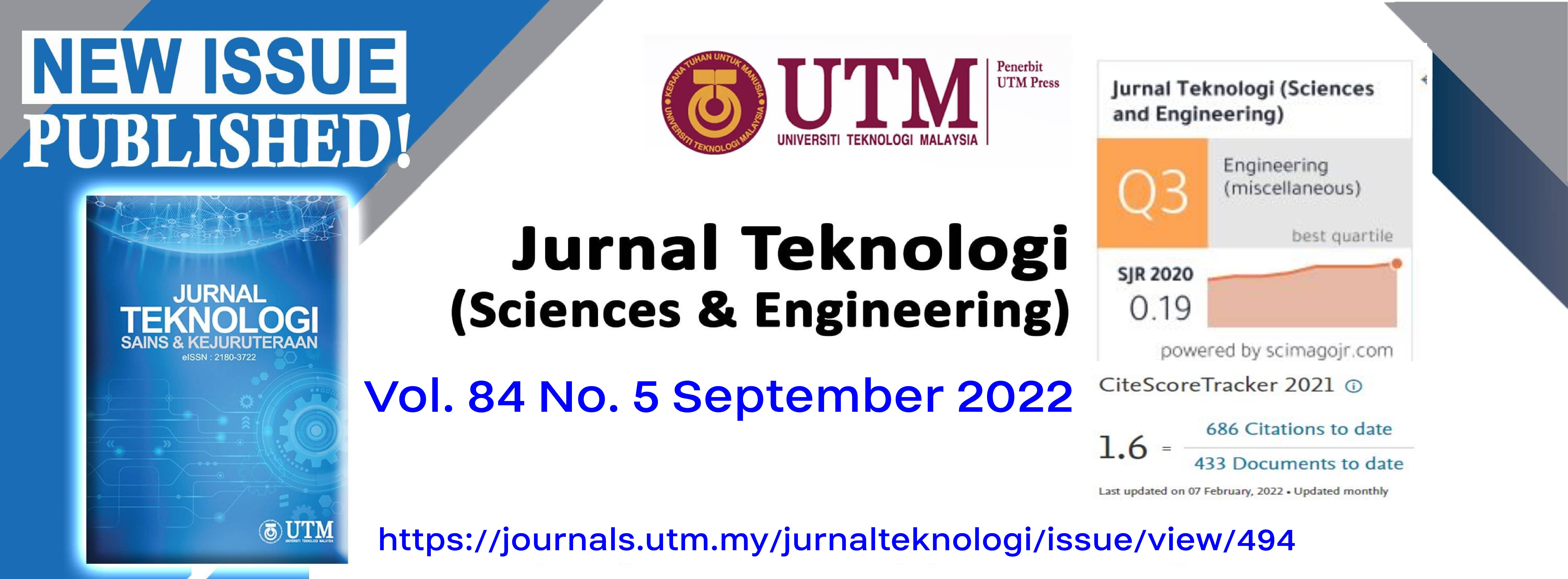TUBULAR LINEAR SWITCHED RELUCTANCE ACTUATOR: DESIGN AND CHARACTERIZATION
DOI:
https://doi.org/10.11113/jurnalteknologi.v84.17902Keywords:
Linear stage, tubular linear electromagnetic actuator, actuator designAbstract
Linear electromagnetic actuator is receiving significant attention due to recent advances in power electronics and modern control methods. This research proposes a three-phase tubular linear switched reluctance actuator (LSRA) for application in the semiconductor fabrication industry. The tubular LSRA has a robust construction, low manufacturing and maintenance cost, good fault tolerance capability, and high reliability in a harsh environment, making it an attractive alternative to a permanent magnet linear actuator. However, the tubular LSRA has a long mover, which increases the possibility of the mover deforming during fabrication. So, a new mover design is proposed to overcome the problem. The proposed mover design allows the traveling distance of the actuator to be modified by adding or removing the rings without changing the shaft. The tubular LSRA prototype is fabricated according to the optimized design. To drive the tubular LSRA, a appropriate switching algorithm method are used to provide the correct switching signal. This method is straightforward, while no extensive knowledge of power electronic converter is required. The developed tubular LSRA can generate a maximum static force of 0.65N. Through the open-loop reciprocating motion, the dynamic responses of the tubular LSRA can achieve a maximum velocity of 210mm/s and maximum acceleration of 8m/s2, which are in the performance range for precision mechanism.
References
Makki, M., and Hemmati, S. 2017. Optimum Design of a Double-sided Permanent Magnet Linear Synchronous Motor to Minimize the Detent Force. Energy Equipment and Systems. 5(1): 1-11.
Chowdhury, J., Kumar, G., Kalita, K., Tammi, K., and Kakoty. S.K. 2017. A Review on Linear Switched Reluctance Motor. Journal of Structural Mechanics. 50(3): 261-270.
Qiu, H., Hu, K., Yu, W., Yang., C. 2018. Influence of the Magnetic Pole Shape on the Cogging Torque of Permanent Magnet Synchronous Motor. Australian Journal of Electrical and Electronics Engineering.14(3-4): 64-70.
Bilgin, O., and Kazan. F. A. 2016. The Effect of Magnet Temperature on Speed, Current and Torque in PMSMs. 22nd International Conference on Electrical Machines (ICEM) 2016. Lausanne, Switzerland. 2080-2085.
He, H., Zhou, N., Sun. C. 2017. Efficiency Decrease Estimation of a Permanent Magnet Synchronous Machine with Dmagnetization Faults. Energy Procedia 2017. 105: 2718-2724.
Hirayama, T., and Kawabata. S. 2017. Study on Design Method for Thrust Ripple Reduction of Double-sided Linear Switched Reluctance Motor. 11th International Symposium on Linear Drives for Industry Applications (LDIA) 2017. Osaka, Japan. 1-5.
Cheshmeh Beigi, H. M. 2017. Electromagnetic Field Analysis of Novel Low Cogging Force, Linear Switched Reluctance Motor, Based on 2-D Finite Element Method. Energy Equipment and Systems. 5(3): 227-240.
Zhang, L., Kou, B., Jin, Y., Chen, Y., and Liu, Y. 2016. Investigation of an Ironless Permanent Magnet Linear Synchronous Motor with Cooling System. Applied Sciences. 6(12): 1-12.
Ganji, B., and Askari. M. H. 2016. Analysis and Modeling of Different Topologies for Linear Switched Reluctance Motor using Finite Element Method. Alexandria Engineering Journal. 55(3): 2531-2538.
Hirayama, T., Yamashita, S., and Kawabata, S. 2018. Design and Analysis of Linear Switched Reluctance Motor with Coreless HTS Excitation Windings for Ropeless Elevator. 21st International Conference on Electrical Machines and Systems (ICEMS) 2018. Jeju, Korea. 1879-1884.
Ravikumar, D., Murty, V. S., and Jain., S. 2016. Linear Switched Reluctance Motor for High Speed Transit System. IEEE Student’s Conference on Electrical, Electronics and Computer Science 2016. Bhopal, India. 1-4.
Luo, X., Zhang, C., Wang, S., Zio, and E., Wang., X. 2018. Modeling and Analysis of Mover Gaps in Tubular Moving-magnet Linear Oscillating Motors. Chinese Journal of Aeronautics. 31(5): 927-940.
M. M., Ghazaly, T. A., Yahya, A. C., Amran, Z., Abdullah, M. A. M., Ali, A. H., Jamaludin, N. M., Ali. 2016. Force Characterization of a Tubular Linear Electromagnetic Actuator using Finite Element Analysis Method (FEM). Jurnal Teknologi. 78(11): 217-225.
Victor, M. H., Jorge, O., and Fortino. M. 2018. Velocity Regulation in Switched Reluctance Motors Under Magnetic Flux Saturation Conditions. Mathematical Problems in Engineering. 1-13.
Kizhakkethil, S. R., and Murugan., S. 2018. Design and Performance Comparison of Permanent Magnet Brushless Motors and Switched Reluctance Motors for Extended Temperature Applications. Progress in Electromagnetic Research M. 67: 137-146.
Lenin, N. C., and Arumugam., R. 2015. Design and Experimental Verification of Linear Switched Reluctance Motor with Skewed Poles. International Journal of Power Electronics and Drive Systems. 6(1): 18-25.
Hairik, H. A., Thejel, R. H., and Hameed., S. 2015. Speed Control of Switched Reluctance Motor Drive Based on PID Controller. Basrah Journal for Engineering Sciences. 15(1): 1-13.
Maslan, M. N., Kokumai, H., and Sato., K. 2017. Development and Precise Positioning Control of a Thin and Compact Linear Switched Reluctance Motor. Precision Engineering. 48: 265-278.
Chen, H., Nie, R., and Yan., W. 2017. A Novel Structure Single-Phase Tubular Switched Reluctance Linear Motor. IEEE Transactions on Magnetics. 53(11): 1-4.
Li, K., Cheng, G., Sun, X., Yang, Z., Fan, Y. 2019. Performance Optimization Design and Analysis of Bearingless Induction Motor with Different Magnetic Slot Wedges. Results in Physics. 12: 349-356.
Okyay, A., Erkorkmaz, and K., Khamesee., M. B. 2018. Mechatronic Design, Actuator Optimization, and Control of a Long Stroke Linear Nano-positioner. Precision Engineering. 52: 308-322.
Kumar, P. C., and Geetha., K. 2015. Design, Modeling and Analysis of Linear Switched Reluctance Motor for Ground Transit Applications. IOSR Journal of Electrical and Electronics Engineering. 10(1): 1-10.
Oiwa, T., Katsuki, M., Karita, M., Gao, W., Makinouchi, S., Sato, K., and Oohashi., Y. 2011. Questionnaire Survey on Ultra-Precision Positioning. International Journal of Automation Technology. 5(6): 766-772.
Downloads
Published
Issue
Section
License
Copyright of articles that appear in Jurnal Teknologi belongs exclusively to Penerbit Universiti Teknologi Malaysia (Penerbit UTM Press). This copyright covers the rights to reproduce the article, including reprints, electronic reproductions, or any other reproductions of similar nature.
















